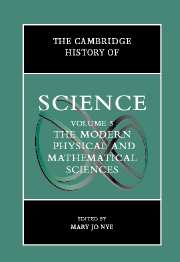Book contents
- Frontmatter
- Introduction: The Modern Physical and Mathematical Sciences
- Part I The Public Cultures of the Physical Sciences After 1800
- Part II Discipline Building in the Sciences: Places, Instruments, Communication
- Part III Chemistry and Physics: Problems Through the Early 1900s
- Part IV Atomic and Molecular Sciences in the Twentieth Century
- Part V Mathematics, Astronomy, and Cosmology Since the Eighteenth Century
- 23 The Geometrical Tradition: Mathematics, Space, and Reason in the Nineteenth Century
- 24 Between Rigor and Applications: Developments in the Concept of Function in Mathematical Analysis
- 25 Statistics and Physical Theories
- 26 Solar Science and Astrophysics
- 27 Cosmologies and Cosmogonies of Space and Time
- 28 The Physics and Chemistry of the Earth
- Part VI Problems and Promises at the End of the Twentieth Century
- Index
- References
24 - Between Rigor and Applications: Developments in the Concept of Function in Mathematical Analysis
from Part V - Mathematics, Astronomy, and Cosmology Since the Eighteenth Century
Published online by Cambridge University Press: 28 March 2008
- Frontmatter
- Introduction: The Modern Physical and Mathematical Sciences
- Part I The Public Cultures of the Physical Sciences After 1800
- Part II Discipline Building in the Sciences: Places, Instruments, Communication
- Part III Chemistry and Physics: Problems Through the Early 1900s
- Part IV Atomic and Molecular Sciences in the Twentieth Century
- Part V Mathematics, Astronomy, and Cosmology Since the Eighteenth Century
- 23 The Geometrical Tradition: Mathematics, Space, and Reason in the Nineteenth Century
- 24 Between Rigor and Applications: Developments in the Concept of Function in Mathematical Analysis
- 25 Statistics and Physical Theories
- 26 Solar Science and Astrophysics
- 27 Cosmologies and Cosmogonies of Space and Time
- 28 The Physics and Chemistry of the Earth
- Part VI Problems and Promises at the End of the Twentieth Century
- Index
- References
Summary
In this chapter I shall illustrate some of the general trends in the development of mathematical analysis by considering its most basic element: the concept of function. I shall show that its development was shaped both by applications in various domains, such as mechanics, electrical engineering, and quantum mechanics, and by foundational issues in pure mathematics, such as the striving for rigor in nineteenth-century analysis and the structural movement of the twentieth century. In particular, I shall concentrate on two great changes in the concept of function: first, the change from analytic-algebraic expressions to Dirichlet’s concept of a variable depending on another variable in an arbitrary way, and second, the invention of the theory of distributions. We shall see that it is characteristic of both of the new concepts that they were initiated in a nonrigorous way in connection with various applications, and that they were generally accepted and widely used only after a new basic trend in the foundation of mathematics had made them natural and rigorous. However, the two conceptual transformations differ in one important respect: The first change had a revolutionary character in that Dirichlet’s concept of function completely replaced the earlier one. Furthermore, some of the analytic expressions, such as divergent power series, which eighteenth-century mathematicians considered as functions, were considered as meaningless by their nineteenth-century successors. The concept of distributions, on the other hand, is a generalization of the concept of function in the sense that most functions (the locally integrable functions) can be considered distributions. Moreover, the theory of distributions builds upon the ordinary theory of functions, so that the theory of functions is neither superfluous nor meaningless.
- Type
- Chapter
- Information
- The Cambridge History of Science , pp. 468 - 487Publisher: Cambridge University PressPrint publication year: 2002



